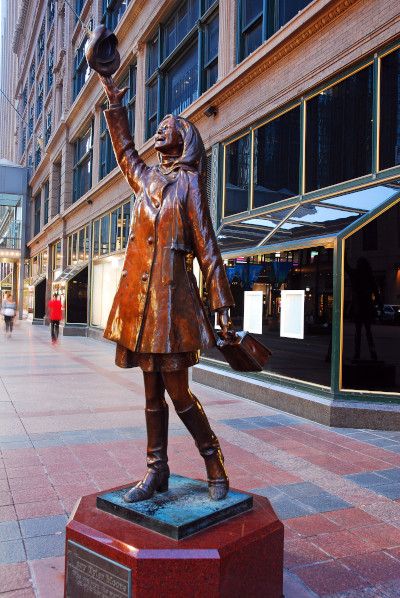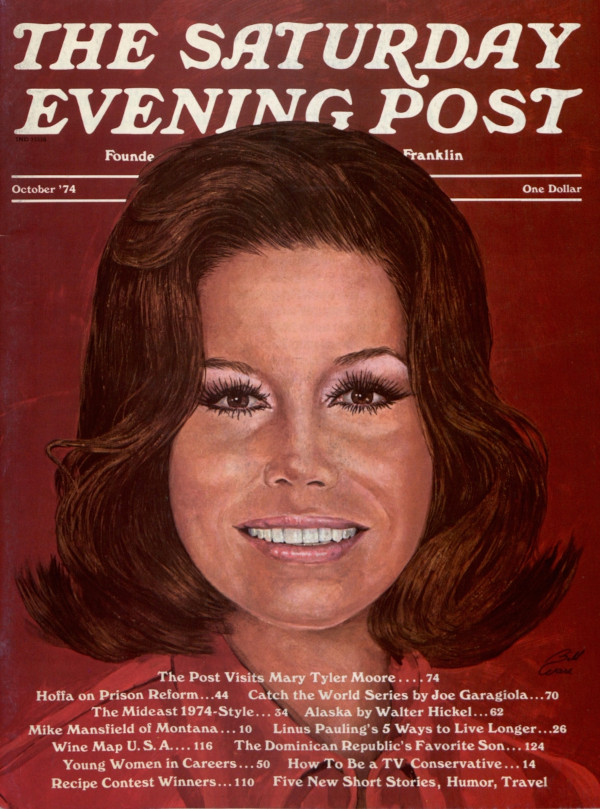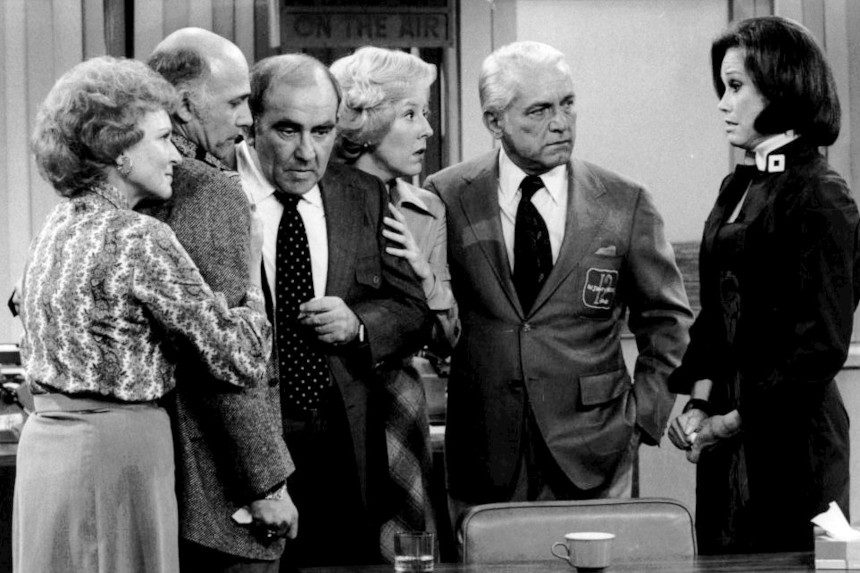It’s easy to say that a show redefined television, but it’s much harder to prove. In the case of The Mary Tyler Moore Show, you might say that the proof is all around. The series recreated the mold of the ensemble comedy. It changed the way that comedy shows were directed. It had a cast that was strong enough to spin off three separate characters into their own series (one of which was a drama!). And it wasn’t afraid to engage in very serious topics, including some that were taboo for the time. The show still shows up on “Best of” lists, including best writing, acting, and direction, as well as Best Finale and Funniest Moment (seriously, the Chuckles funeral). It’s a program where everything still holds up remarkably well five decades later. That’s right; The Mary Tyler Moore Show launched 50 years ago, and TV is much better because of it.
Series co-creator Allan Burns started writing in animation, working on Jay Ward productions like The Rocky and Bullwinkle Show. He co-created The Munsters and worked as a story editor on Get Smart. James L. Brooks broke into TV news in the 1960s on the writing side. Brooks met Burns at a party, and Burns got him TV writing work. After working on several shows, Brooks created Room 222; when he left after the first year to develop other projects, he got Burns to come aboard as producer. Soon after, Grant Tinker, a programming executive at CBS, hired the duo to create a show for his wife. His wife happened to be Mary Tyler Moore, who was already beloved and famous for her long-running role as Laura Petrie on The Dick Van Dyke Show. Leaning on Brooks’s background, they decided to build the show around the goings-on in a metropolitan TV newsroom with Moore’s Mary Richards as the associate producer at the center.
Mary Tyler Moore on casting (Uploaded to YouTube by FoundationINTERVIEWS)
The nucleus of the newsroom cast was Moore, Ed Asner, Gavin MacLeod, and Ted Knight; Valerie Harper and Cloris Leachman played Mary’s best friend, Rhoda, and neighbor, Phyllis, respectively. Over the years, as Harper and Leachman left for spin-offs devoted to their characters, the cast would add Georgia Engel and Betty White to great effect. The Mary Tyler Moore Show managed to be both entertaining and relevant. Mary Richards was single throughout the tenure of the show, and not forcing the character to be defined by a man or relationship was groundbreaking. Similarly, Rhoda grappled with body image issues. No character was one-note; even Ted Knight’s Ted Baxter, for his incompetent bluster, had moments of humanity and deepened further when Engel’s Georgette was added to the cast as his wife. The shading of each character, rather than simply assigning a type and relying on it, became a sitcom staple.
While the actors made it all work, the writing and directing had a great deal to do with it. Brooks would apply the dynamics of ensemble building to shows like Taxi and The Simpsons. When you watch an episode like “Chuckles Bites the Dust,” you’re witnessing something akin to an eight-sided tennis match; each character is bouncing jokes and responses back and forth, but the jokes are all rooted in that particular actor’s character. When Mary can’t control her giggles during the clown’s funeral, and later bursts into tears, it’s funny because a) it’s funny, b) it’s believable human behavior, c) it’s all true to what we know about Mary, and d) it’s deeply relatable. If you’re thinking that the same principles apply to many episodes of the show, you’d be right.
Another important facet of the show was the fact that it didn’t turn its back on difficult topics in society. Like the aforementioned personal struggles that Mary and Rhoda had, characters faced personal difficulties or were involved in plots that brought up issues of the day (and today). One memorable moment came in the episode “You’ve Got a Friend;” when Mary’s visiting mother told Mary’s father not to forget to take his pill, he and Mary both replied, “I won’t,” implying, of course, that Mary was on birth control. The show also addressed equal pay for women and many more storylines that remain relevant today.
As the show went on, appreciation for it grew. It pulled in 29 Emmys, including three for Outstanding Comedy Series in 1975, 1976, and 1977. Moore also won three times for Outstanding Lead Actress in a Comedy Series. It was a solid Top 20 entry in the ratings for most of its run, with three years spent in the Top Ten. When the show received a Peabody Award in 1977, it came with the state that the show had “established the benchmark by which all situation comedies must be judged.” Since the show’s end after its seventh and final season, it has routinely placed on lists recounting the best in television, including lists from TV Guide, Entertainment Weekly, and USA Today. In 2013, the Writers Guild of America put it number six on their list of the best written television series of all time.

After the series ended in 1977, a third spin-off, Lou Grant, was launched. Ed Asner led the series for five seasons, during which it won 13 Emmys, two Golden Globes, and its own Peabody. Plans were made for Mary and Rhoda to reunite in a sitcom; however, those were later abandoned. Mary and Rhoda did meet up again in the 2000 TV movie Mary and Rhoda. A 2002 reunion special brought the entire surviving cast back together (Knight had passed in 1986) for a retrospective look at the series. Today, all seven seasons are available to watch on Hulu.
After the series, Moore worked continuously across film, television, and theater. She earned an Oscar nomination for her role in 1980’s Ordinary People. She and Tinker divorced in 1981, and she married Robert Levine in 1983. A type 1 diabetic, Moore served for years as the international chairperson for the Juvenile Diabetes Research Foundation. She was also active in animal rights and in the restoration and preservation of Civil War history. Moore passed way in 2017 at the age of 80.
The Mary Tyler Moore Show left an indelible mark on television. You can see its DNA in everything from Cheers to Friends to The Office. Any show with a workplace at the center is bound to be compared to it, and any show that features adults talking to each other like adults recalls its boldness. Few shows are daring enough to make you laugh at a clown’s funeral; far fewer could make it one of the most memorable scenes in TV history. A classic by any measure, the show’s impact likely never go away. It certainly made it, after all.
During the run of the show, the Post went behind-the-scenes with Moore in a wide-ranging interview from 1974. You can read that story below.

Featured image: Cast photo from the television program The Mary Tyler Moore Show. After the news that most of the WJM-TV staff has been fired, everyone gathers in the newsroom. From left: Betty White (Sue Ann Nivens), Gavin MacLeod (Murray Slaughter), Ed Asner (Lou Grant), Georgia Engel (Georgette Baxter), Ted Knight (Ted Baxter), Mary Tyler Moore (Mary Richards). (Publicity Image from CBS Television; Public Domain via Wikimedia Commons)
Become a Saturday Evening Post member and enjoy unlimited access. Subscribe now




Comments
Gene Newman, that quote you mentioned between Asner and Mary was/is a classic, from the very first episode. Thank you for mentioning it! I forgot to mention Mary wore a natural looking wig (long hair) in the first season to really differentiate herself initially from the Laura Petrie character so ingrained in the public’s mind.
Everyone associated with the new show didn’t want to risk confusion (by less bright people) to have to get bogged down explaining she was not the ‘Laura’ character, while trying to establish Mary Richards! The wig was a simple, effective tool that did the trick perfectly. Mary was just so beautiful in the final 3 seasons, and her great, short(er) hairstyles definitely contributed to that.
I wish the main article gave more credit to Ed Asner who was great in his part a the station’s boss. “Mary, you’ve got spunk!” he said. And as Mary was thanking him for the compliment, he added, “I hate spunk!”
I instinctively knew a feature on this show had to be coming this month, and here it is. It absolutely holds up extremely well 5 decades later. It was the perfect collaboration of the right people at the right time, place, and decade. In a decade infamous for bad clothes and hair styles, The Mary Tyler Moore Show made everyone look good then and they still do now, never mind the show otherwise.
In the 2nd link here (when Mary passed away) I put comments in that although the show did deal with some serious-ish topics, it was never done with any kind of heavy hand. Points were made through the comedy and didn’t have to become “serious” to be put across. This was NOT a “women’s liberation” show, which is a reason it isn’t “dated” today, unlike ‘All in the Family’.
The show highlighted/utilized the various actors talents and tendencies beautifully. Unlike Lucille Ball or Carol Burnett (my two other favorites) who generated the laughs by their own antics, Mary was more of a ‘reactor’ at what the people around her were doing. It worked and suited her perfectly.
The trend in TV from about 1974 to ’79 were spinoffs. Some were very good like ‘Maude’ and ‘The Jeffersons’. Others not so much, like ‘The Ropers’, ‘Rhoda’ and ‘Phyllis’. ‘Rhoda’ was a big deal in the beginning with her wedding, but went downhill quickly after that, with she and her husband fighting/arguing for several years. ‘Phyllis’ who was smart and clever on MTM, was anything but on her own show, unfortunately. It wasn’t worthy of Ms. Leachman.
Meanwhile, Mary’s own show didn’t weaken due to their departures. Betty White as Sue Ann was one of the most brilliant characters ever created. After being used to her roles on MTM and ‘Ellen’ on Carol Burnett’s “Family” skits, I didn’t enjoy seeing her as one-dimensional caricature ‘Rose’ on ‘The Golden Girls’ a decade later. Same with Rue McClanahan of ‘Maude’ on there as ‘Blanche’. Not funny, and really degrading to women. The intelligent ‘Designing Women’ CBS created with Dixie Carter, Jean Smart and Delta Burke, was fortunately just the opposite.
I love all 7 seasons of ‘The Mary Tyler Moore Show’, but particularly season 5 (’74-’75). Part of it was I just loved how beautiful Mary had gotten as the show went on. I loved seeing her have more responsibility as the associate producer. Two of my favorite episodes involved her unlikely involvement with ‘Sherry’ a young woman trying to get herself on the right career track, and Mary helping her become a dress designer.
Everyone’s favorite episode is ‘Chuckle’s Funeral’ and it’s one of mine too for sure, but there are so many. In honor of the show’s 50th birthday, I’m going to re-watch it from the first to last episode starting this week, one a day or every other day. Thanks for including the 1974 Post cover and feature, too. I got my parents to re-subscribe to it in ’73 shortly after its revival, but bought myself a no-label newsstand copy of THIS issue. $1 and no tax for that full-size magazine, my goodness. Seems surreal now, like it was someone else, but no. I still have it too!